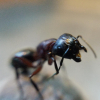- Formiculture.com
- Forums
- Gallery
- Members
- Member Map
- Chat

Mettcollsuss's Ant Journals (Updated 23 Oct 2023)
Started By
Mettcollsuss
, Apr 8 2019 8:59 AM
189 replies to this topic
#141
 Offline
-
Posted December 18 2020 - 1:39 PM
Offline
-
Posted December 18 2020 - 1:39 PM
It’s my freshman year too, but all my ants died and/or escaped so I don’t have to worry about getting rid of some. Still hopeful for my Crematogaster queens to miraculously show up.
- TennesseeAnts likes this
#142
 Offline
-
Posted February 12 2021 - 7:30 AM
Offline
-
Posted February 12 2021 - 7:30 AM
Aphaenogaster picea
Finally spent the time to properly ID this colony. Took them out of hibernation about a week or two back, and they've been doing well. They've been accepting their offerings of a steady stream of small dubia nymphs, so I'm hoping a new batch of eggs is around the corner. They're much more sweet-loving than my past Aphaenogaster colony. I've given them a feeder with some ant nectar in it, which there is usually at least one worker drinking from at any given moment. Ever since I added it, every single worker has a noticeably pumper gaster.
some long overdue photos (apologies for the glare)
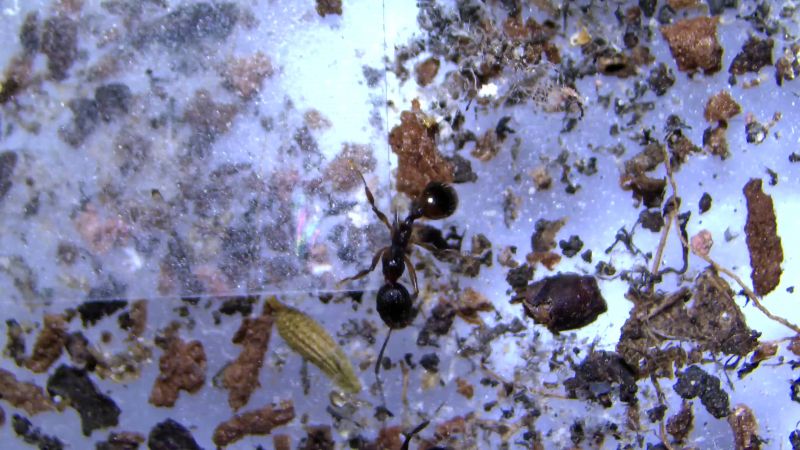
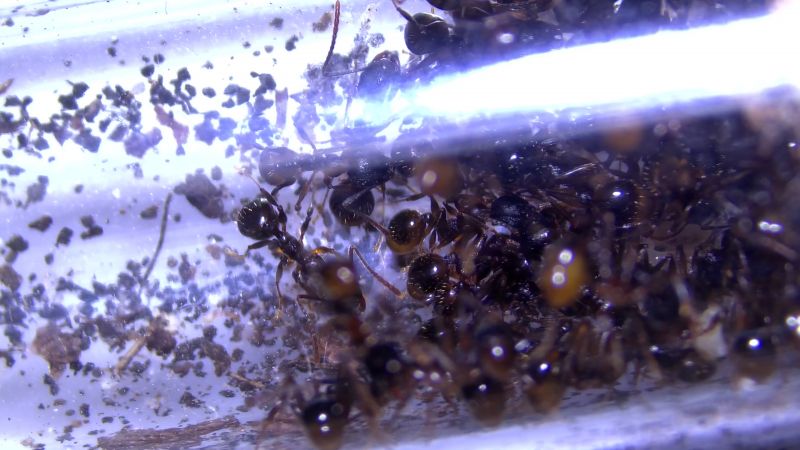
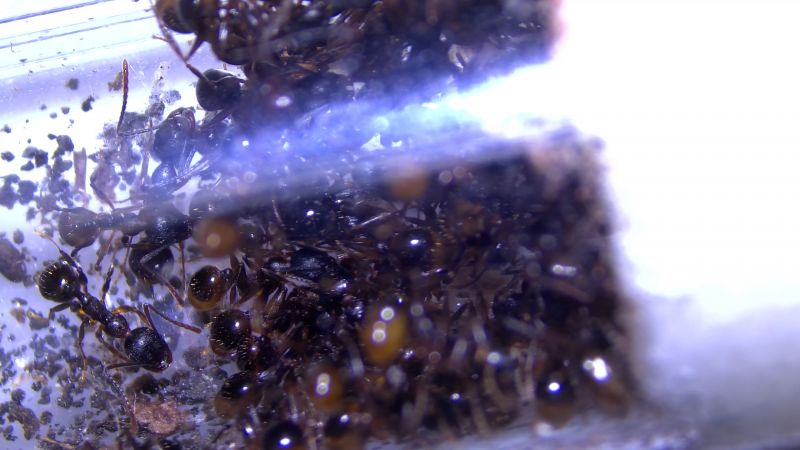
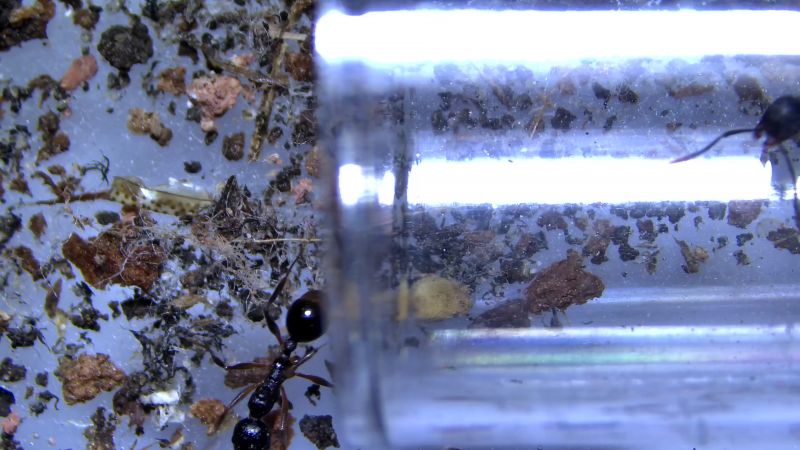
Tetramorium immigrans
Attached a second outworld to their setup. Knowing them, I expected it to be trashed pretty much immediately but it's been kept surprisingly clean. I've also discovered that they're very fond of the kibble I feed my hedgehog, but I guess that makes sense for a species as omnivorous as them
The other colonies are still in hibernation but will probably come out sometime this month.
- FeedTheAnts and TacticalHandleGaming like this
#143
 Offline
-
Posted March 19 2021 - 9:15 AM
Offline
-
Posted March 19 2021 - 9:15 AM
All the colonies have been out of hibernation for about a month now. All of them are doing well and have started to produce their first brood for the year. The Tetramorium have more brood than I was expecting, particularly pupae. The Formica lost a noticeable portion during hibernation but a remaining workers seem to be healthy. I saw worker carrying this year's first clutch of eggs today. I've also noticed a new feeding behavior since I took them out of hibernation. Whenever they're given an insect, after it's been dragged into the nest, a single worker will start moving the trash pile to completely block the entrance to the nest. None of the others try to help or stop her. Whatever the case, it's definitely interesting.
Edited by Mettcollsuss, March 19 2021 - 9:15 AM.
- TennesseeAnts and ANTdrew like this
#144
 Offline
-
Posted March 22 2021 - 6:22 PM
Offline
-
Posted March 22 2021 - 6:22 PM
Camponotus pennsylvanicus
Added a second tube to their setup after the first one started to run low on space and water. At first they seemed to use it as a food processing space. But now that I've added a heating cable to the first tube, they seem to be using the two tubes as hot and cold nests, respectively.
Formica subsericea
Not a huge deal, but they accepted a darkling beetle for the first time today when they've always refused them before. In the past, the only colony I've had that's readily accepted adult darkling beetles are my T. immigrans, (and sometimes C. pennsylvanicus, though with more hesitation).
Prenolepis imparis
The P. imparis in my area had their flights today, and I caught eight queens, as well as three alate queens. I divided the eight viable queens into a three queen colony, a two queen colony, and three one-queen colonies. I plan on keeping most in pretty standard setups, though I do have an old dirt box laying around that I was thinking could make a good setup for this species.
My question on that is whether the single or multi-queen would work better for a dirt box. My concern with multi-queen is that they may dig separate founding chambers and found separate colonies. If that happens, would the separate colonies merge as they grow and expand into each other? I would assume so, given that their nests would be a couple inches away at most so their scents would probably mingle some, but I want to play it safe so I thought I'd ask.
Tapinoma sessile
While searching for P. imparis queens, I found a some T. sessile living in the leaf litter. It could have just been a young colony, but I think it's more likely to be a satellite colony, based on how abundant T. sessile are around me. I collected six queens, though one got damaged and later died. I haven't gotten a good estimate on the number of workers yet. There's not a ton, but there should be enough to get the colony healthy and growing.
- ANTdrew likes this
#145
 Online
-
Posted March 23 2021 - 2:20 AM
Online
-
Posted March 23 2021 - 2:20 AM
How large is your Formica colony now?
- TennesseeAnts likes this
"The ants are a people not strong, yet they prepare their meat in the summer." Prov. 30:25
Keep ordinary ants in extraordinary ways.
Keep ordinary ants in extraordinary ways.
#146
 Offline
-
Posted March 23 2021 - 5:34 AM
Offline
-
Posted March 23 2021 - 5:34 AM
The P. imparis should group together since they are polygynous.
#147
 Offline
-
Posted March 29 2021 - 6:07 AM
Offline
-
Posted March 29 2021 - 6:07 AM
Formica subsericea
By my very rough estimate, I'd say that they're at around 130-140 workers. At a glance, it certainly seems like a lot less since they're clustered so tightly. Their first batches of eggs have hatched into small/mid size larvae. I always forget how quickly this species goes through the egg and larval stages compared to other ants, but then how long they spend in the pupal stage. I'm thinking about moving them soon, since their current nest is getting pretty moldy.
Camponotus pennsylvanicus
A little over half the workers and brood have moved to the new tube. The area in front of the tubes has become a gathering area for them as well. It probably helps that that's right next to their food dish as well. They've got several large larvae that seem ready to pupate soon. I observed a new behavior in them yesterday. They took one of their larvae outside of the tube and gathered around it just gnawing on it. There was a second larvae also outside the tube, sitting on the food dish actually, but the workers weren't attacking(?) it like they were the other one.
Tetramorium immigrans
I've noticed a pattern with how they use their heating cable and how hydrated the nest is. If there isn't an abundance of moisture, then they prefer to cluster in the bottom layer, near the water tower. If there's more moisture, then they'll keep the queen and larvae (and I assume eggs) in the bottom layer, but move the pupae to cluster around the heating cable. I noticed this pattern the other day when I accidentally overfilled their water tower. When I first attached the cable a couple weeks ago, they quickly moved to take advantage of it, but abandoned it a couple days later. It wasn't until a couple days ago when I accidentally overwatered them that they suddenly moved back to the heating cable. And now they've moved back away from it, right around the time there's not any visible extra moisture. But now I know that if I want them to take advantage of the heating cable and develop faster, I just have to keep them more hydrated.
Tapinoma sessile
At first they were a little picky and sensitive about food, but they've quickly adapted and are now eating well. They've already got a small and growing cluster of eggs. It also turns out my initial count of their queens was off, and they have eight living queens. They're living in a medium outworld at the moment, though I may move them to an actual formicarium later. The outworld has the aspirator vial I collected them in and a test tube setup. I had put the test tube in there for them to move into, but they're living in the vial instead, and just sending out workers to occasionally drink from the test tube and bring the water back to the rest of them.
- TennesseeAnts likes this
#148
 Offline
-
Posted April 4 2021 - 1:49 PM
Offline
-
Posted April 4 2021 - 1:49 PM
How are the neorufibarbis doing? I'm interested as I'm raising my own colony at the moment now.
"You don't get what you want. You get what you deserve".
#149
 Offline
-
Posted April 8 2021 - 11:22 AM
Offline
-
Posted April 8 2021 - 11:22 AM
The F. neorufibarbis ended up dying off, I just forgot to update that. They just never produced brood after I took them out of hibernation. I have the queen preserved. I might be able to catch another one when I go camping up in Michigan this summer at the same spot I caught this one.
Formica subsericea
Just a whole lot of larvae. I'm trying to get them to move into a mini hearth (maybe two, if they prove too large for it) since their current nest is getting really dirty, but they've started using it as trash storage instead.
Tapinoma sessile
I found a second colony nesting in the other side of the yard from where I collected the first one. This new colony has only two queens but more workers than colony #1. Based on how populous T. sessile is around my house, I assumed that there was some massive colony nearby that these two were both satellites colonies of, but they appear to be unrelated colonies. When I introduce a worker from one colony to another, they are approached very slowly and cautiously, only by one or two workers, and there's some tentative antenna and leg tugging. It's far from a full-fledged invader response. I hope that if I work to slowly introduce them to each others scents, I might be able to eventually combine them. Both colonies are eating well and have tons of eggs.
Camponotus pennsylvanicus
First pupae for the year
Prenolepis imparis
It's a little too far into the founding stage for them to dig a new nest. Luckily I found a single queen from one of the later smaller flights, and I was able to move her into the dirt box. She's settled in and dug a founding chamber. All the other queens have eggs.
#150
 Offline
-
Posted April 8 2021 - 2:57 PM
Offline
-
Posted April 8 2021 - 2:57 PM
Sorry to hear the news about your queen. Best of luck in Michigan.
"You don't get what you want. You get what you deserve".
#151
 Offline
-
Posted April 9 2021 - 12:29 PM
Offline
-
Posted April 9 2021 - 12:29 PM
Do you have the permit necessary to bring that species across state lines?
#152
 Offline
-
Posted May 4 2021 - 7:42 AM
Offline
-
Posted May 4 2021 - 7:42 AM
Formica subsericea
First workers have started eclosing. Lots of brood and becoming very protein hungry. Most pupae are naked despite them having plenty of substrate available
Tapinoma sessile
Brood seems to be developing fairly slowly, but there's tons of it. Each colony has a few small and mid-sized larvae and a massive bundle of eggs.
Camponotus pennsylvanicus
First new worker of the year has eclosed. Moved them into a THA fortress, which they took to very quickly.
Tetramorium immigrans
Had a population boom recently. There's always a lot more workers patrolling the outworlds now, and they're constantly clustering the larger brood around the heating cable.
- TennesseeAnts and Antkeeper01 like this
#153
 Offline
-
Posted June 4 2021 - 10:05 AM
Offline
-
Posted June 4 2021 - 10:05 AM
Tetramorium immigrans
Gave them a piece of raw chicken yesterday, which has been completely consumed over the past 24 hours. I can't see their egg piles, and I also can't see (most) of their larvae, but they're definitely there as there's always a large pupae pile clearly visible. Their intake of sweets has increased lately, which matches with the fact that I started ramping up their protein a couple weeks ago.
Workers clustering around a larger and off-color larvae. Either an alate or a larger worker. Whatever the case, it appears to be the only larvae of its kind.
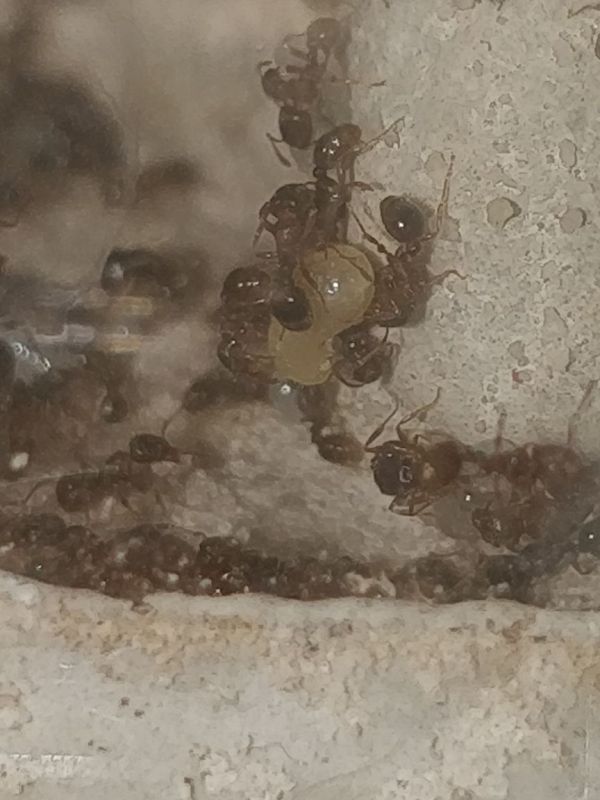
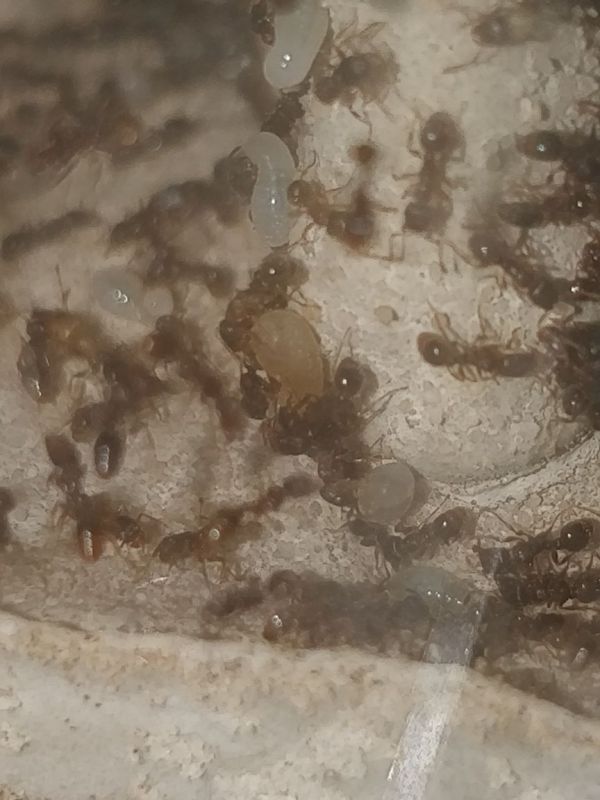
Camponotus pennsylvanicus
All pupae have eclosed. I can't get a good estimate, but there's a new batch of eggs and small larvae developing. I've been increasing frequency of protein feedings, which should help them make up for the lack of growth last year. They've moved the main nest chambers to the top two chambers of the fortress, and are using the bottom chambers as a prey processing area, and a place for the workers that can't fit in the upper chambers to hang out.
Formica subsericea
One or two batches of brood have already eclosed this year, significantly increasing the population, and more batches in every stage of development. Each new batch seems larger than the last. I had expected their labyrinth to last them through at least the rest of this year but at this rate it might not.
A peek into their nest. They immediately started evacuating the larvae from the water tower as soon as I moved the red filter. I had been giving the colony blue sugar water, which is visible in the larvae. The colony is producing both cocoons and naked pupae.
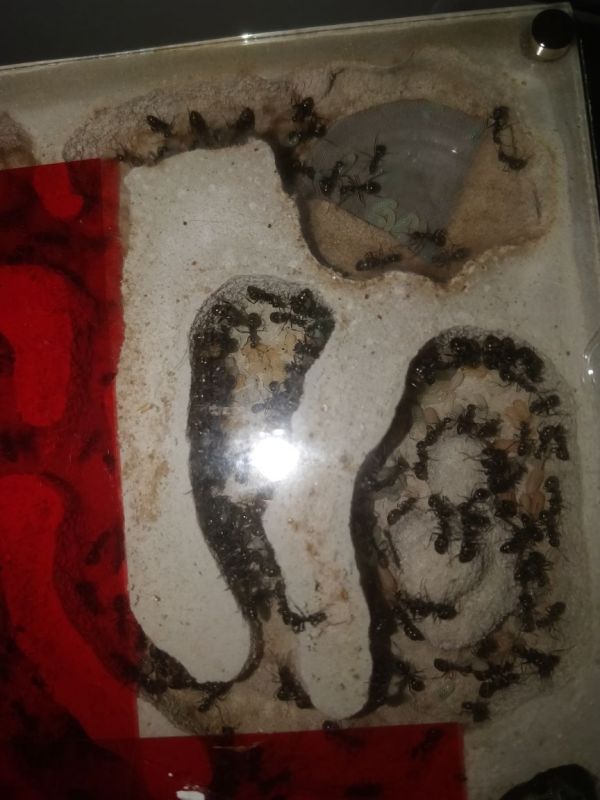
Prenolepis imparis
Almost all have nanitics now. I've started offering sugar water, but they're still not very receptive to protein.
Tapinoma sessile
Moved the 8-queen colony into a THA mini hearth. Lots of pupae are eclosing, though the new workers are smaller than the existing ones so I should probably increase feedings.
Photos before and during the move.
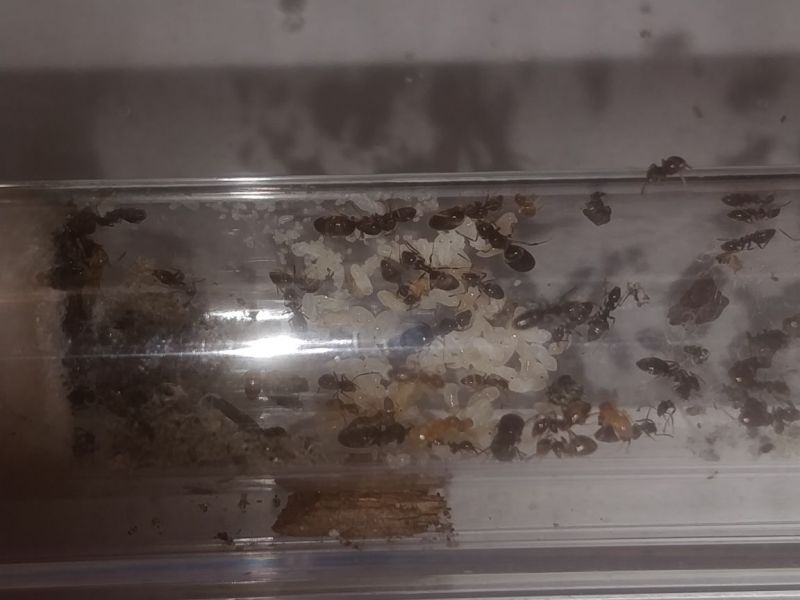
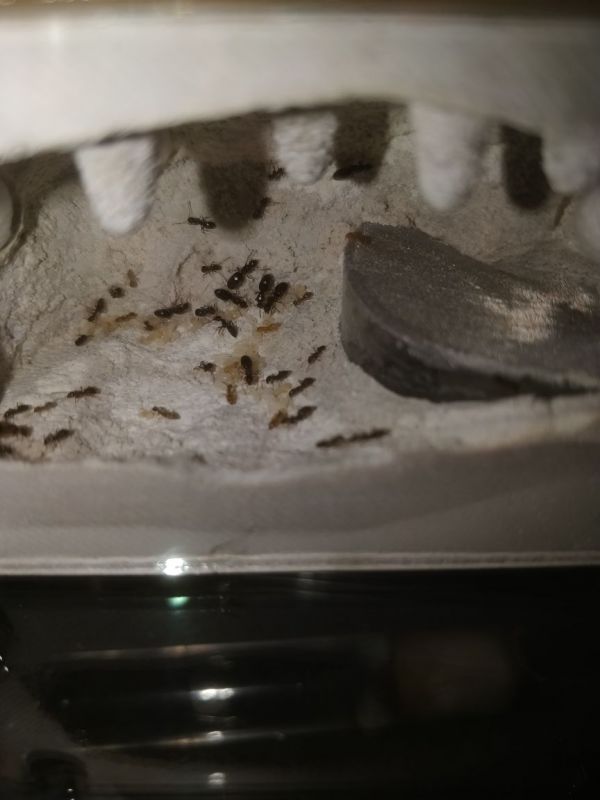
Crematogaster cerasi
Bought a founding colony of Crematogaster. Microscope confirmed that they are C. cerasi. The colony's in not the greatest but not the worst condition. When I picked them up they had two test tubes connected, trying to move them from a dry tube to a new one. I assume that they hadn't been fed since the tubes were connected, but I don't know how long that was. The new tube had a decent amount of condensation and some dead workers. The colony was still hanging out in the dry tube. Between the ones that were dead already, and a couple that have died since, I'd say about 8-10 have died. The remaining colony has the queen, eggs, and 8 workers. The remaining workers seem healthy and are readily accepting sugar water and pieces of dubia nymph, so I'm fairly hopeful about their chance of recovery. I've placed their dry tube in a small outworld with a new tube connected. They haven't moved into the new tube, but they are visiting it to drink.
Worker drinking drop of sugar water

- TennesseeAnts, ANTdrew, Antkeeper01 and 1 other like this
#154
 Offline
-
Posted June 9 2021 - 5:27 AM
Offline
-
Posted June 9 2021 - 5:27 AM
Formica subsericea
Using dyed sugar water has proved pretty interesting, as it allows me to see how food travels through the colony. As expected, it quickly ended up in all the workers, but more interestingly all the larvae also ended up with blue stomachs. But what seems the most interesting to me is that all the feeder insects end up turning blue on the inside as the colony processes them. I can see workers passing around small pieces of blue cockroach meat. I wonder why/how their sugar water is involved with breaking down insects. I've started trying to mimic the feeding behaviors I see in the wild, which is many smaller prey items as opposed to one larger one. I've been giving them smaller feeders/smaller pieces of feeders that can be dragged in by only one or two workers, which is what I see in the wild. They seem to be more responsive to prey presented this way, and they're eating more feeders overall after this switch.
Tetramorium immigrans
Had another great escape the other day. This time it wasn't due to a weak spot in a barrier, or an open lid, but their formicarium is just old and worn down enough that they can now slip through the cracks. After a few unsuccessful attempts to repair it, I just threw their whole setup into large bin with a barrier plus a moat for extra safety. I had been thinking about getting them a new setup anyway.
Before the escape, I noticed a decent number of larger-than-average, plump larvae about the size of the one in the previous update. Either they're producing larger workers now, or have reached alates. Both would make sense with the increased protein I've been giving them.
- TennesseeAnts, Kaelwizard and ANTdrew like this
#155
 Offline
-
Posted June 13 2021 - 6:24 PM
Offline
-
Posted June 13 2021 - 6:24 PM
Camponotus pennsylvanicus
More brood developing. Lots of eggs. They keep moving the bulk of the colony back and forth between the heated chamber and the non-heated chambers.
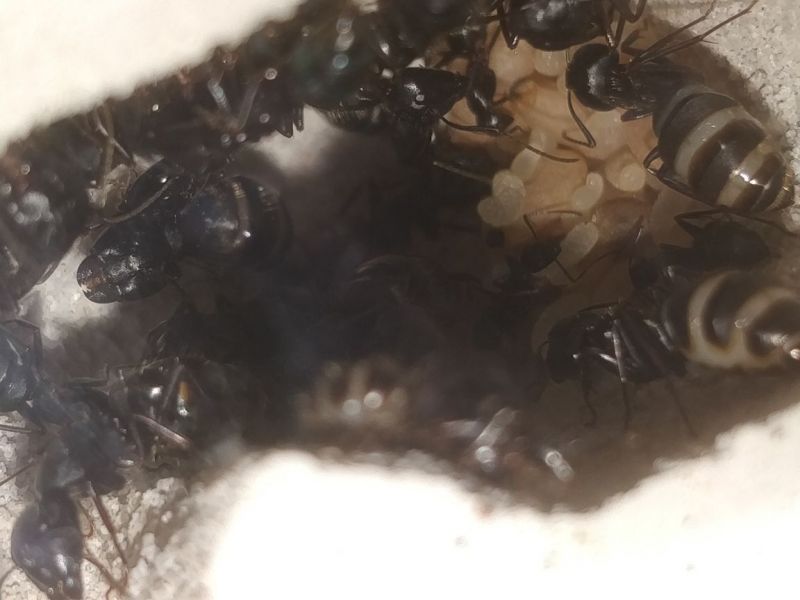
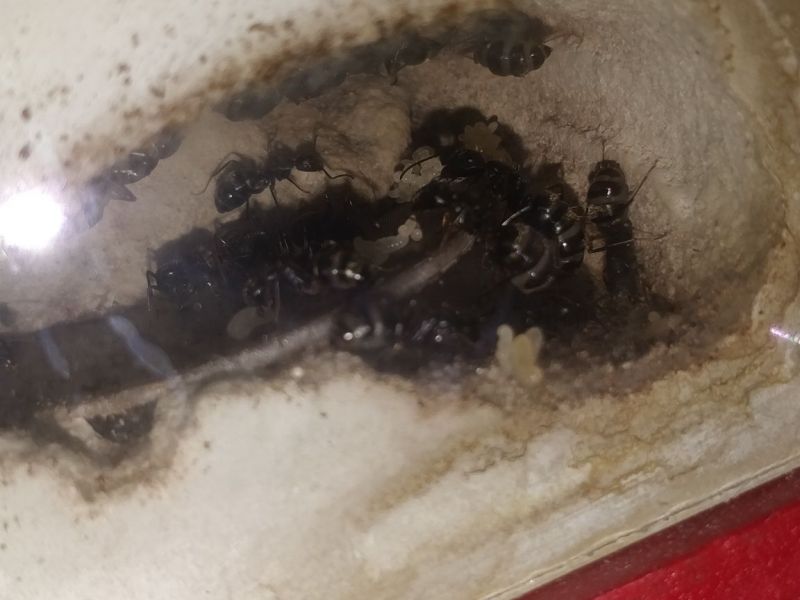
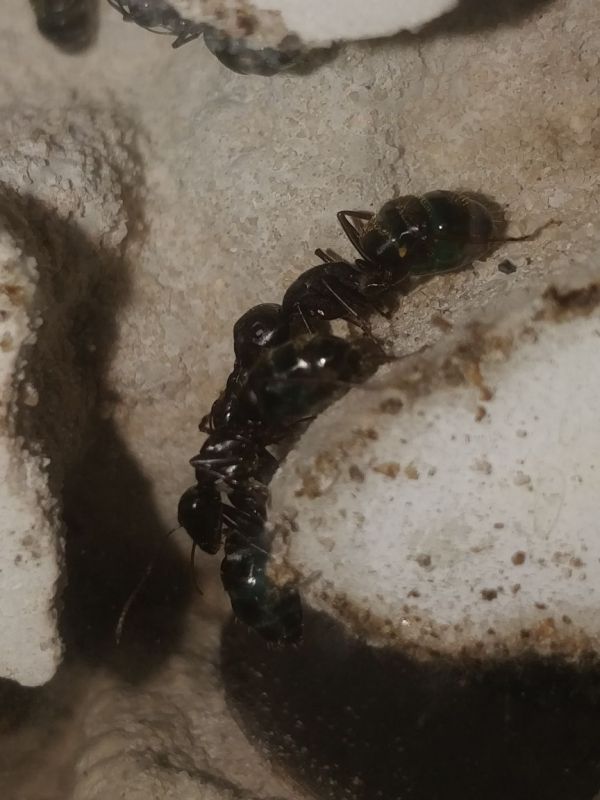
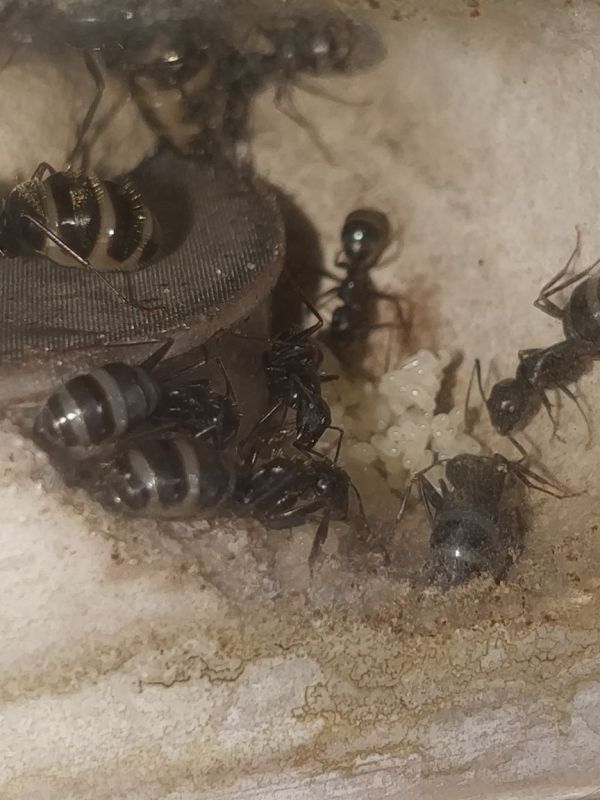
Crematogaster cerasi
The colony has fully moved into the new tube. Most of the workers and the eggs have been moved in for a few days. But the queen was stubborn and wouldn't move in until I covered the new tube and used a straw and cotton to make the entrance smaller.
Worker holding the colony's eggs near the heating cable.
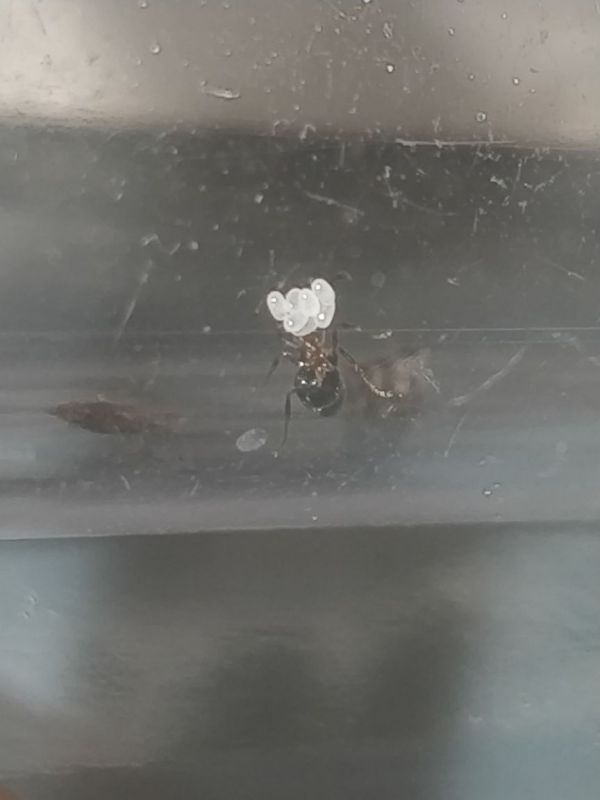
Queen & attendees still in the old tube
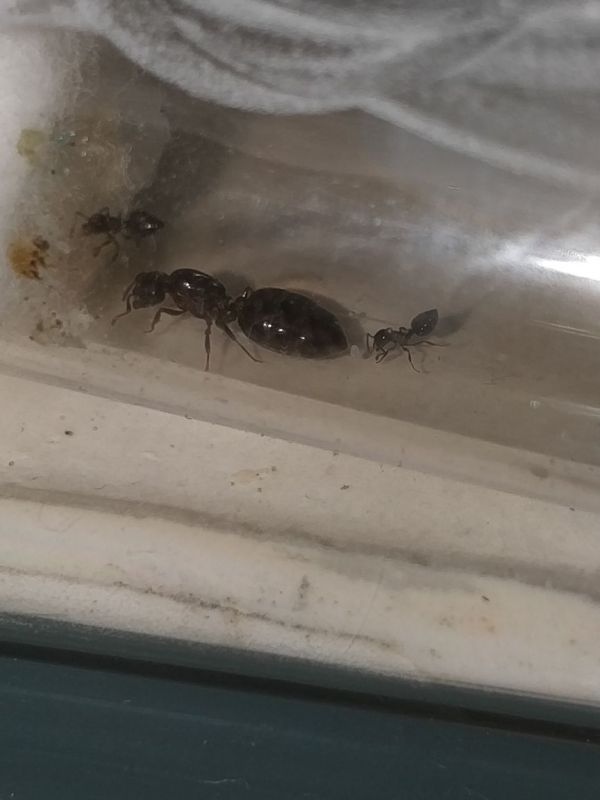
Formica subsericea
Very large amounts of pupae and soon-to-pupate larvae. For some reason the vast majority of their pupae are naked despite them having enough substrate to spin cocoons with. They're quickly making up for their year of very little growth last year. The queen also seems more active now, and regularly travels between the various brood chambers instead of staying in just her one main chamber as she used to. I hooked up a heating cable a few days ago, and they reacted how they usually do to heat. They immediately clustered around it with as many workers and pupae as they could, but then after a day or so they started avoiding the heated corner.
One of the brood chambers
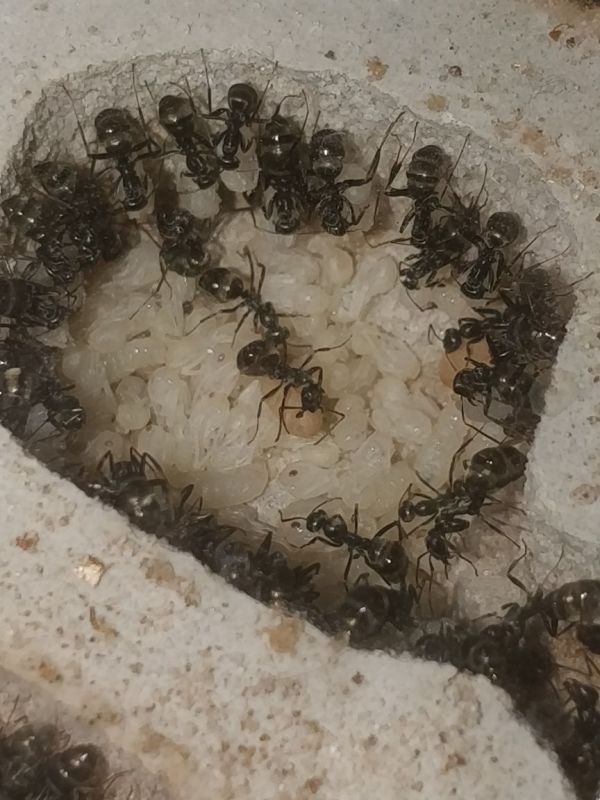
Tapinoma sessile
All eight queens are still healthy and I assume all are laying based on the size of the egg pile. I added a feeder of blue sugar water, which very quickly became visible in every worker and later the larvae.
Part of the colony clustering around the heated side of the mini hearth
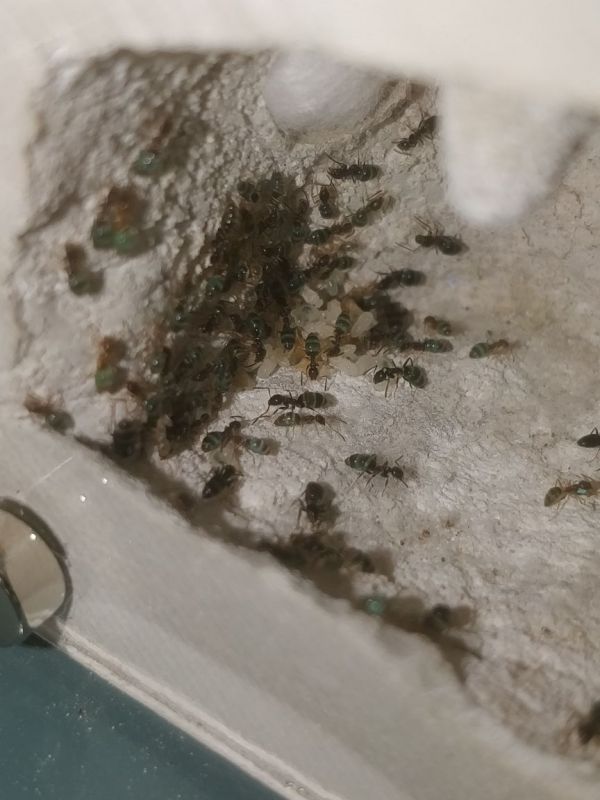
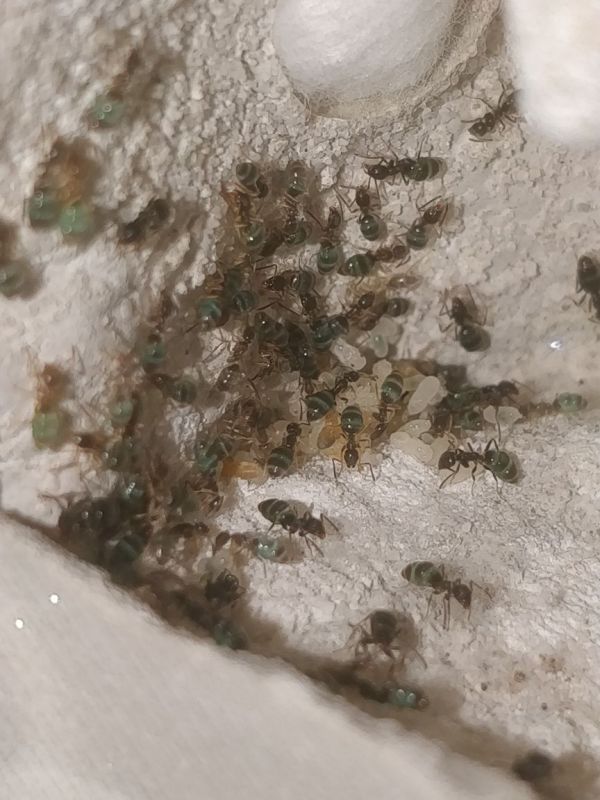
Visiting the liquid feeder
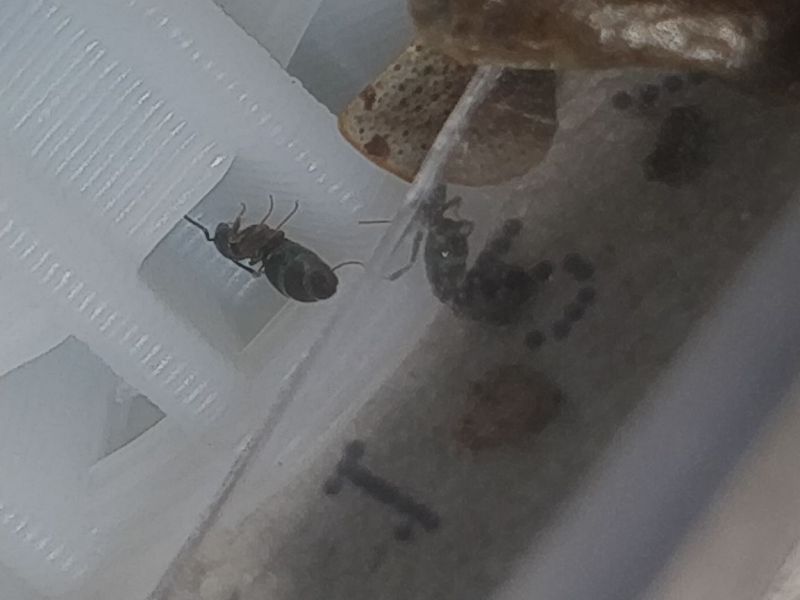
#156
 Offline
-
Posted July 1 2021 - 3:12 PM
Offline
-
Posted July 1 2021 - 3:12 PM
Aphaenogaster picea
Slowly but surely growing. They've got a larger appetite now and are accepting of larger prey. The tube they've been in since I caught them almost a year ago finally started to run low on water, so I added a new tube to their outworld next to their current one. They started using it very quickly. The queen and the bulk of the brood are still in the old tube, but there are always ~30-40% of the workers hanging around in the new tube. I'm content with leaving these guys in a tubs & tubes setup for the foreseeable future. I considered moving them to one of the small acrylic nests I have available, but decided against it. They seem perfectly fine in their current setup, and Aphaenogaster are great at making acrylic nests dirty really fast.
Formica subsericea
Workers have been eclosing, and new larvae are pupating to take their place. I can't see any eggs, but there's always larvae so they've got to be there somewhere. In the past they've had distinct batches of brood with long breaks in between, but now they've got brood of all stages all the time. My idea of feeding them multiple smaller prey items seems to be doing well.
I've heard some mixed reports about this species being polygynous or not. I imagine it's something that varies region to region and/or between populations. I'll probably be catch some new queens soon, and I hope to be able to experiment with this.
Prenolepis imparis
All remaining queens have reached nanitics. Interestingly, the founding colony with the most queens had the least nanitics at first (only 1) and was the last to have nanitics eclose. They readily accept sugar water, but are still very apprehensive about insects.
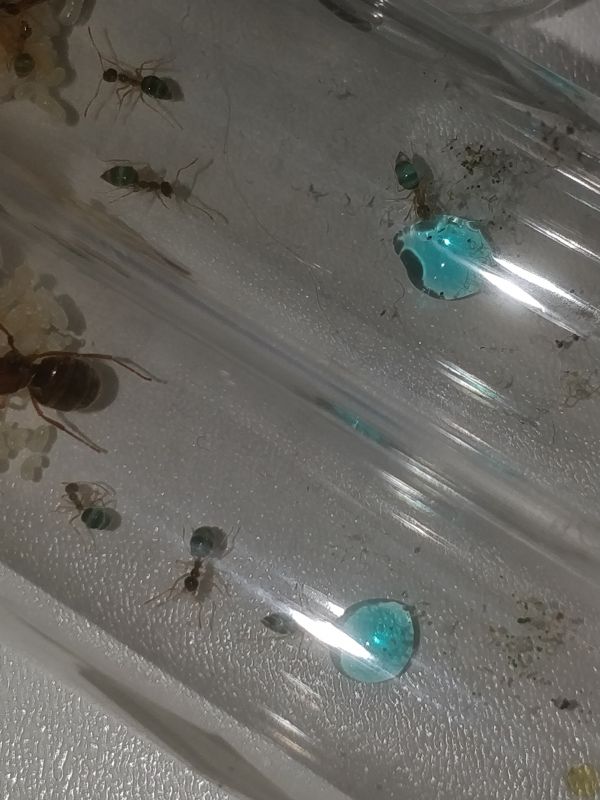
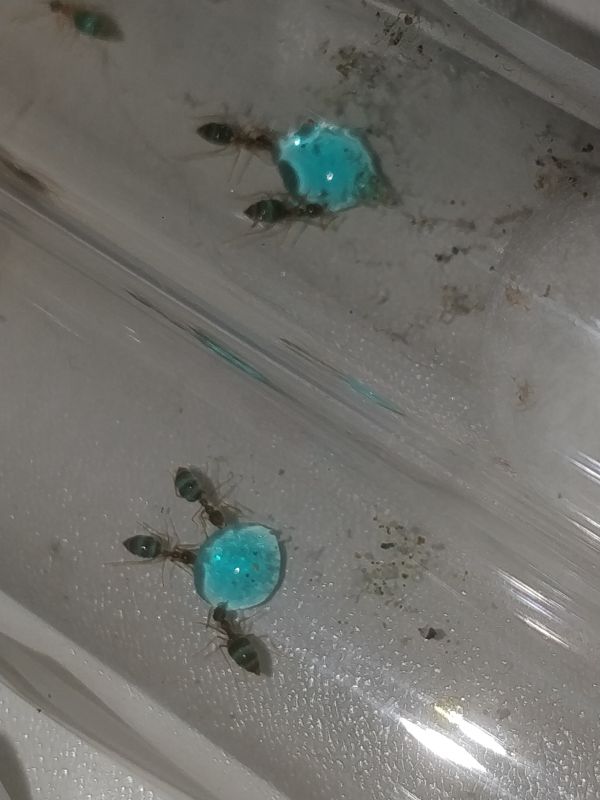
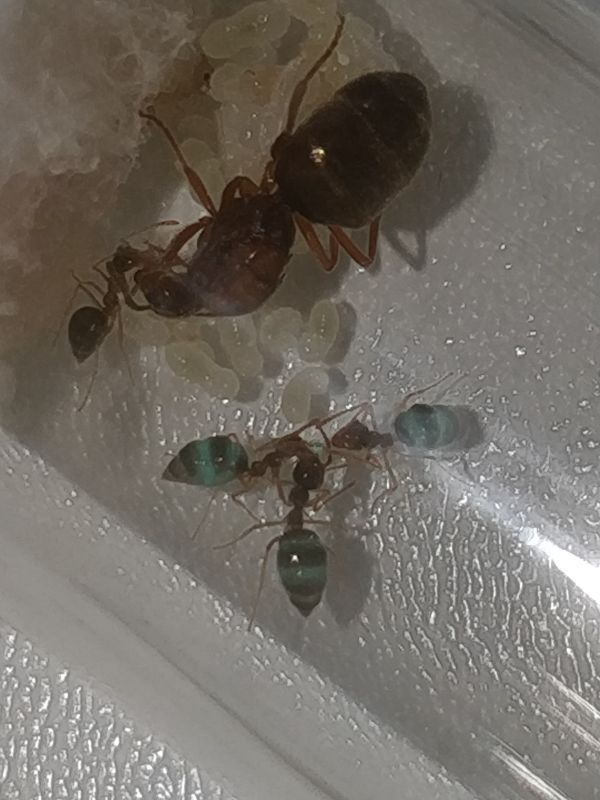
Tapinoma sessile
The brood pile has decreased in mass, but the number of brood seems to be the same. Most of the larger brood has matured into workers now, but there's still plenty of eggs. The eggs should hatching and bringing the pile back to it's original size or larger soon.
Tetramorium immigrans
They're doing well in their temporary bin setup. They've established a small garbage pile in each of the corners. At first they kept escaping at a slow rate of a few workers a day, so I put a moat around the bin. I bought some fluon, and after applying it I had no more escapees.
I've got three founding colonies so far this year (though in one they all still have their wings and don't have any eggs yet), and I'll likely be catching a lot more soon.
#157
 Offline
-
Posted July 27 2021 - 6:32 PM
Offline
-
Posted July 27 2021 - 6:32 PM
Aphaenogaster picea
Definitely my slowest-growing colony at the moment. The brood pile is slowly gaining size, and the population is still slowly but surely increasing. They are now nesting in both tubes, though their older tube is still their main one. Their appetite, especially for protein, is growing noticeably.
Camponotus pennsylvanicus
The large batch of spring brood have all fully developed and eclosed. The brood pile is now much smaller. I'm hoping another large batch of eggs is on the way soon.
I caught a new queen while I was up in Michigan these past couple weeks. She seems pretty healthy and already has a pile of eggs. I'll probably sell her once her colony gets to a decent size.
Formica subsericea
They have brood later into the season than they have in past years. Whenever I look into the nest I only see pupae, but they always have pupae so they must have their other stages of brood somewhere in the nest.
I managed to catch three new F. subsericea queens while I was in Michigan. Unfortunately I wasn't able to try the polygyny experiment because I caught them all a few days apart from each other, and I'd rather do this experiment with ones that flew on the same day.
Formica pallidefulva-group
Earlier in my antkeeping, I had traded for some F. pallidefulva founding colonies, but I sold them because I wasn't interested in them at the time. Looking back on it, I wish I had kept one. Luckily, I caught a pallidefulva-group queen while I was at camp. I found her on the shore of the small lake that the camp is near, which is interesting because all the pallidefulva-group workers I saw were further away from the water. The queen settled into her test tube quickly, and had eggs the next day. She's also pretty calm and not easily startled, at least for a Formica queen. Once workers arrive, I'll get a species ID.
Formica integra-group
On that same beach I also found a parasitic Formica queen trying to invade a large F. subsericea colony. I was worried she would be sanguinea-group, since they're the only parasitic Formica I've seen in that area before. Luckily she had no clypeal notch. After catching her I set her tube down and went over to the colony she was trying to invade to collect host pupae. Unfortunately she was very agitated by being caught and the vial she was in didn't have any ventilation so she ended up formic acid poisoning herself to near death. I actually thought she was dead and was ready to put her in some alcohol to preserve her. On the walk back to my cabin, she started twitching her legs a tiny bit, so I decided to move her into a well ventilated vial and wait. The next morning she was standing upright again, but still largely paralyzed. After another day, she could move all her limbs as well as her head. I moved her into a test tube with the F. subsericea pupae. As of now a few of the subsericea host workers have eclosed, and the queen can move around decently well (but she still has partially paralyzed back legs and often seems disoriented). Even though she came back from near death, she still has her wings so I'm not very hopeful that she'll be fertile.
Formica fusca-group
On that same beach I found fusca-group queen. At first I assumed she was F. subsericea since they're the only black Formica I've seen there before, and because I found her crawling over a large subsericea mound. But once I got back to my cabin and had her tube sitting next to the actual F. subsericea queens I had, she was noticeably smaller, had less pubescence, and was much glossier. I'm not sure what species she is. My best guess is maybe F. subaenescens based on the smaller size and glossiness. For now I'll just leave her at fusca-group until I can run some workers through a key. Hopefully I'm not speaking too soon, but it looks like she'll be getting workers since she also settled in and laid eggs quickly.
Tapinoma sessile
I had a small scare that colony #1 had completely stopped producing brood, but it turns out that it was just that all their older brood fully matured. They've got a pretty good pile of eggs, but nothing else. They had just positioned the eggs in a place that I couldn't see them, so it looked like they had no brood. It looks like they're producing brood in distinct batches.
Yet again, from that same beach, I found T. sessile queen. She's doing pretty well at the moment, but I haven't had good luck with founding T. sessile in the past, so we'll see.
Lasius (Lasius)
Another queen from the same beach. She's probably Lasius neoniger, as L. cf. neoniger is very abundant in the area. Any clearings in the surrounding forest are very densely populated with their mounds. She's very dark in color, so L. americanus could be a possibility, but a dark L. neoniger (or maybe pallitarsis) seems more likely.
Lasius (Chthonolasius)
I caught six total Chthonolasius queens over the past two weeks. At first I assumed they were all L. aphidicola, but I noticed some glossiness that makes me think they may be L. speculiventris. It's possible that I caught some of both. Now there are only three left, two of which are together. The living queens seem to have glossy abdomens, but the dead ones look more aphidicola-like when I put them under a microscope. If founding is successful, I'll ID some workers. For hosts, I collected some L. cf. neoniger workers and pupae. I'm still working on introducing the queens to the hosts, but it may take a little while since they're acting pretty aggressive towards each other. I'll make another update that goes more into detail about their introduction once I'm done introducing them.
- TennesseeAnts and Antkeeper01 like this
#158
 Offline
-
Posted August 3 2021 - 1:12 PM
Offline
-
Posted August 3 2021 - 1:12 PM
Lasius speculiventris
I confirmed that the Chthonolasius queens I caught were Lasius speculiventris. The host workers I collected keyed out to L. americanus, which should be a better host than L. neoniger. I have the two remaining speculiventris queens sharing a tube. I'm not sure if they're polygynous, but it'll be a fun experiment. One of the queens has a damaged gaster, so if it turns out they're monogynous after all, at least I know which one will be going. Thankfully, the damaged gaster doesn't seem to be negatively affecting her health.
I started by introducing 1-2 workers, which would be killed by the next morning. I would then add another couple. Over several days of this, they went from acting aggressive to sitting together on the same side of the cotton. Even though they were sitting together, I would still find the hosts dead the next morning. Yesterday, I took a little over half of the host pupae and added them into the parasite tube. I also added a few workers, enough that they should be able to care for the pupae, but still few enough that the queens should be able to survive if the workers decide to be aggressive. I tried to add only callow workers, but a few non-callows got in as well. Looking back on it, that's probably good since the non-callows will carry more colony scent on them. I tossed them in the fridge overnight since the queens and new workers were fighting again. I took them out of the fridge this morning and they're much more accepting of each other. All the queens, pupae, and workers were sitting together in the same pile. I've seen the queens grooming each other, performing trophallaxis with each other, and one of them grooming a callow worker.
Now that there are workers, the queen hierarchy is more obvious than when is was just the two of them. The queen with the intact gaster seems to be dominant over the one with the damaged gaster, which is what I expected. I've seen the intact queen standing on top of the injured queen a few times, which I'm pretty sure is a signal of dominance between queens. It looks like not much is known about L. speculiventris' biology, so the more observations like this I can make the better.
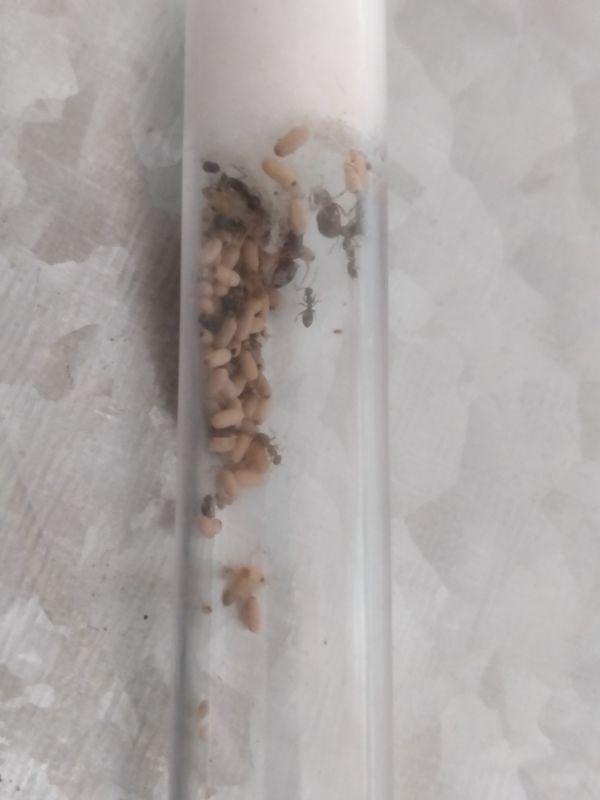
- NickAnter likes this
#159
 Offline
-
Posted August 4 2021 - 9:49 AM
Offline
-
Posted August 4 2021 - 9:49 AM
Lasius speculiventris
I just check on the L. speculiventris colony to find one of the queens dead. As I expected, the one that died was the one with the damaged gaster. It's possible that she died on her own, but it seems much more likely that she was killed off by workers. If the host workers did kill her, then it could be a good or bad sign depending on how you look at it. On one hand, it could mean that the queens aren't being accepted and the other one could be next. On the other hand, it could just be that L. speculiventris are monogynous, and the intact queen was accepted so they had to get rid of the other one. I'm feeding them some sugar water to see if I can catch any host-parasite trophallaxis as a sure sign they were accepted. I made the sugar water blue so hopefully I'll be able to see it appear in the queen's gaster if they are feeding her.
- TennesseeAnts likes this
#160
 Offline
-
Posted August 6 2021 - 1:10 PM
Offline
-
Posted August 6 2021 - 1:10 PM
Formica cf. incerta
I finally broke out my okayish macro camera instead of just using my phone camera. I noticed that she has erect hairs on her thorax, which rules out F. pallidefulva. Now that F. pallidefulva is ruled out, I think it's safe to say that she's F. incerta since F. biophilica and F. dolosa probably don't range as far north as where she was found. Still, I'll wait until I can key a worker to be safe. She has a pupae now, and more on the way. Based on the size of the pupae, Formica nanitics are even smaller than I remember. Some of the subsericea queens and the unidentified fusca-group (cf. subaenescens?) also have pupae.
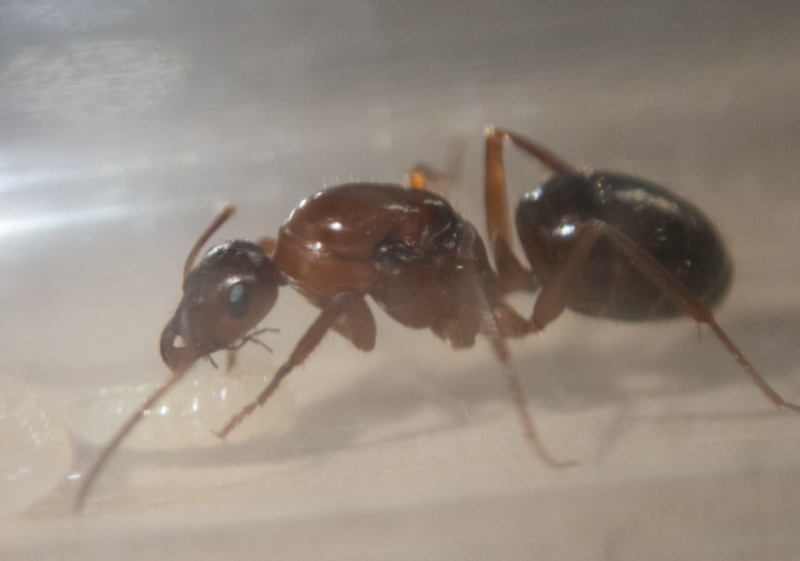
Lasius aphidicola
The queen has been almost completely accepted by the hosts. Whenever I add in new host workers, they get riled up and there's a small bit of aggression from some workers, but it all settles down quickly. I think it's gotten to the point where the queen and her attending host workers smell pretty similar to the original colony. Some callow workers are already starting to eclose, which should help.
The queen's gaster is starting to get larger. It could be eggs, it could be the sugar water I've started to feed them. Either way it's a good sign. If it's egg production would mean the queen feels accepted enough by the hosts and if it's sugar water, that would mean the workers are likely feeding her.
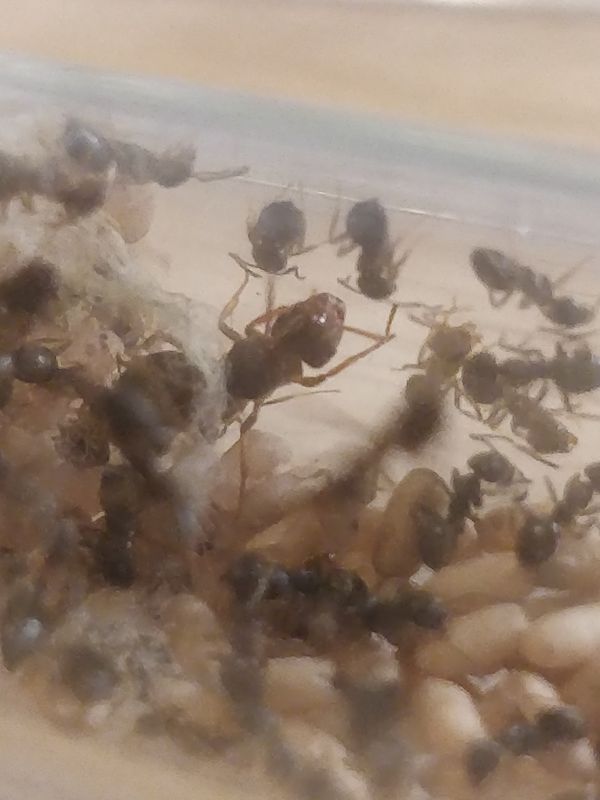
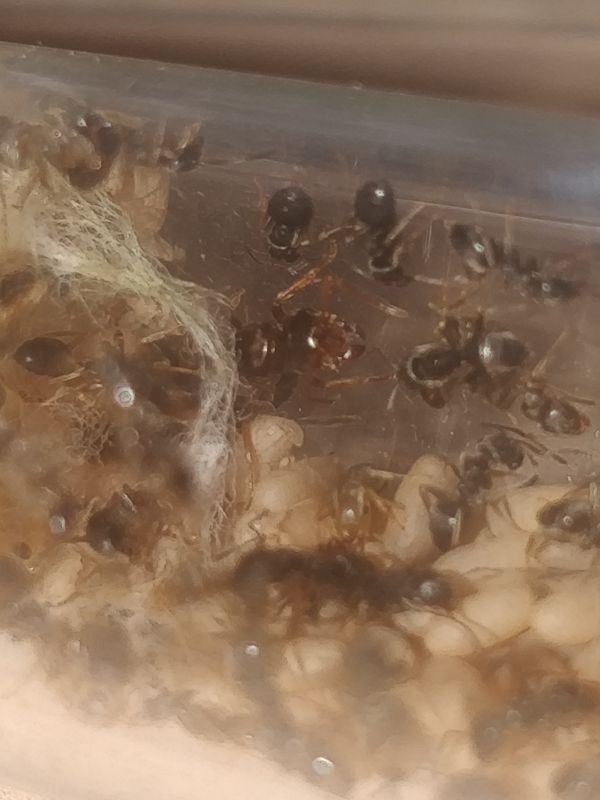
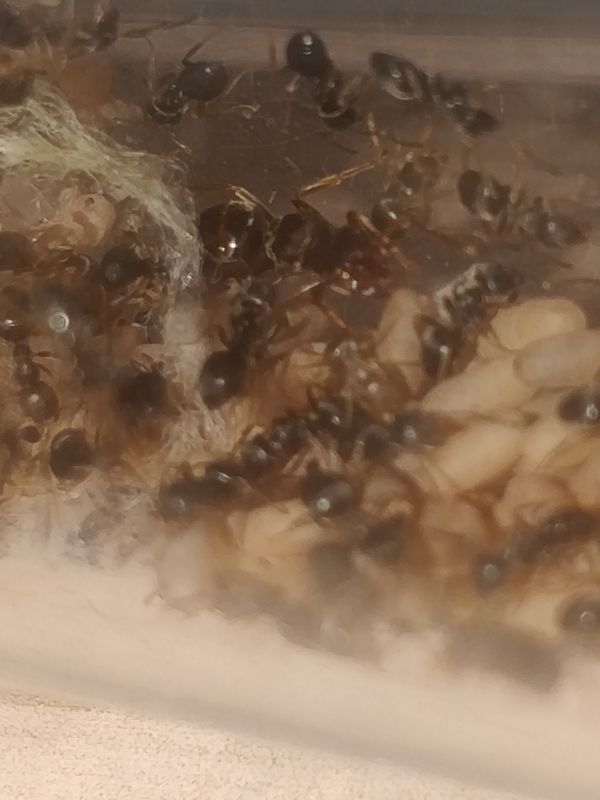
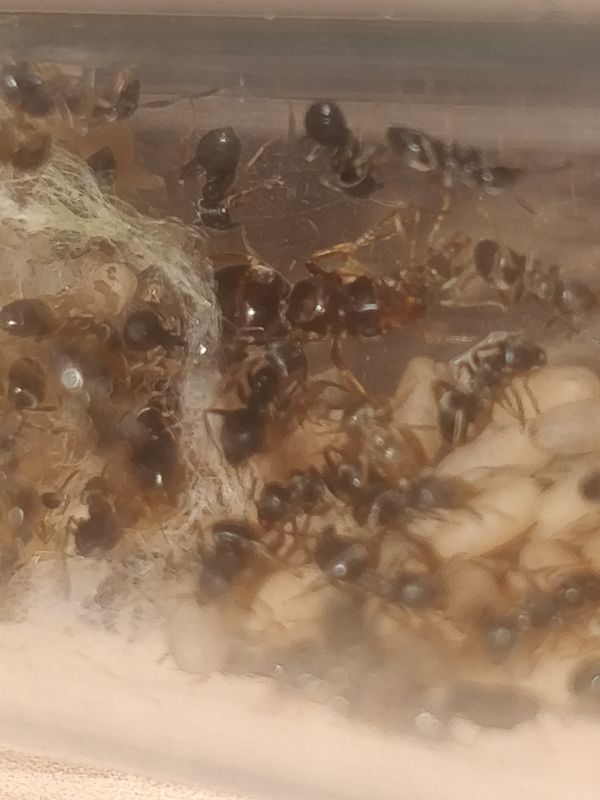
Tetramorium immigrans
Getting ready to move them to their new nest. I took the front off their THA Phalanx nest in the hopes that they would move into the tubes I had put into the outworld. The plan was to move the test tubes into the outworld of their new setup once they moved into them, but it doesn't look like they're gonna do that. The next plan is to just use an aspirator to collect them all and get them into the new nest.
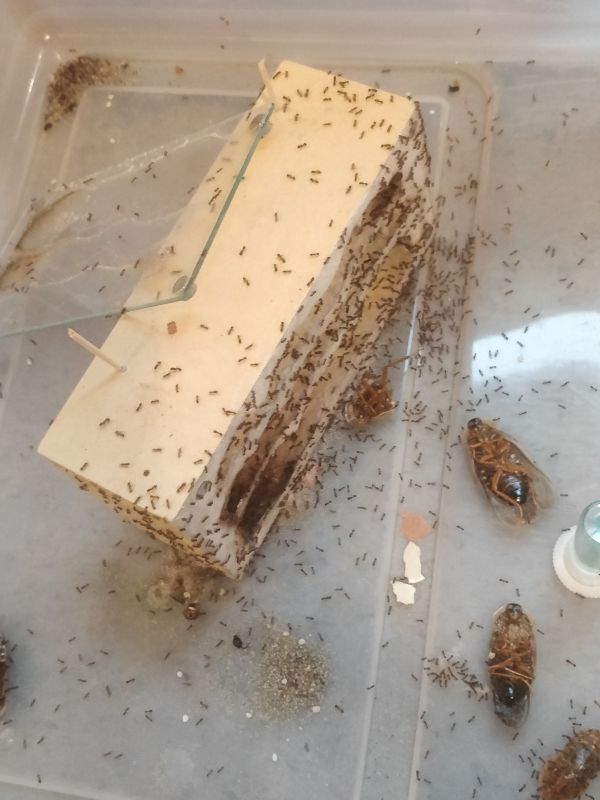
- AnthonyP163, Antkeeper01 and m99 like this
0 user(s) are reading this topic
0 members, 0 guests, 0 anonymous users






